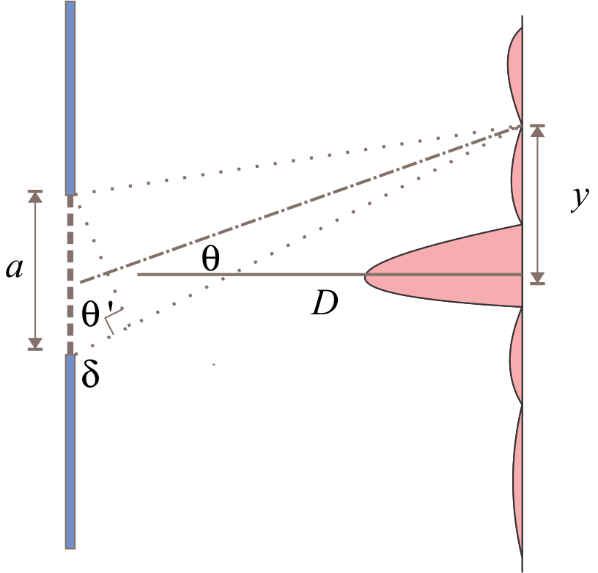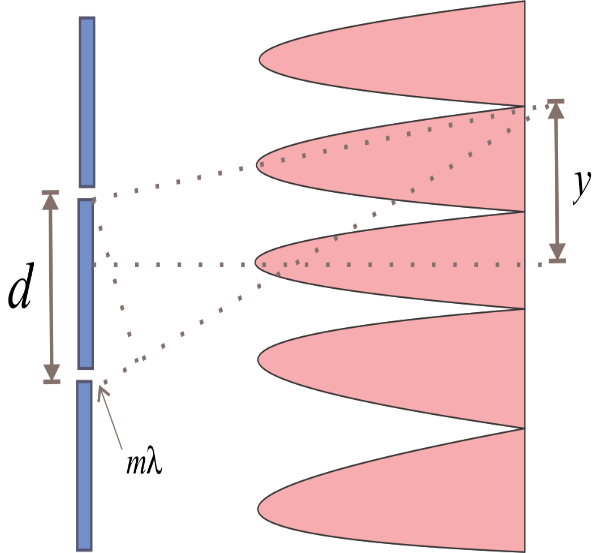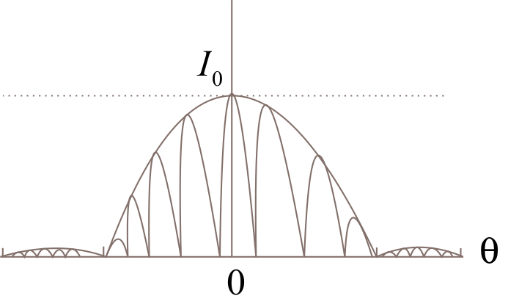
What should be the width of each slit to obtain $10$ maxima of double slit interference pattern within the central maximum of single slit diffraction pattern?
Answer
218.7k+ views
Hint: This is a complicated question the students should have a deep knowledge on the single and double slit experiment to understand the question. We should know about the relation between the double and single slit experiment so that we can understand the question properly.
Complete step by step answer
Single slit diffraction: Single slit diffraction occurs in a single slit experiment where light waves from a source passes through a single slit of width ‘w’ which is in the order of the wavelength of the light wave passing through it to get a distinctive pattern called diffraction pattern.
Double slit experiment: double slit diffraction occurs in a when where light waves from a source passes through a two slits of width ‘w’ which is in the order of the wavelength of the light wave passing through it to get a diffraction pattern.
When the double slit in Young’s experiment is replaced by a single narrow slit (illuminated by a monochromatic source), a broad pattern with a central bright region is observed. On both sides, there are alternate dark and bright regions, the intensity becoming weaker away from the centre the angular size of the central maximum increases when the slit width decreases. The double-slit experiment, is actually a superposition of single-slit diffraction from each slit or hole.


Single slit experiment Double slit experiment
In the diagram,
a and d are the width of the slit.
y is the central maximum.
The angular width of the central maximum of single slit diffraction is $2\theta = \dfrac{{2\lambda }}{a}$
Where,
$\lambda $ is the wavelength
$a$ is the width of the slit
The angular width of the central maximum of double slit diffraction is $2\theta = \dfrac{\lambda }{d}$
$\lambda $ is the wavelength
$d$ is the width of the slit
The angular width of the central maximum of single slit diffraction is $2\theta = \dfrac{{2\lambda }}{a}{\text{ }} \to {\text{1}}$
Width of each slit to obtain $10$ maxima of double slit interference pattern within the central maximum of single slit diffraction pattern $ \Rightarrow 2\theta = 10 \times \dfrac{\lambda }{d}{\text{ }} \to {\text{2}}$
The double slit interference pattern of 10 maxima (The envelope shows the single slit experiment)

We have to find the width of each slit to obtain $10$ maxima of double slit interference pattern within the central maximum of single slit diffraction pattern.
Equate 1 and 2
$ \Rightarrow \dfrac{{2\lambda }}{a} = 10 \times \dfrac{\lambda }{d}$
$ \Rightarrow a = \dfrac{d}{5}$
$a$ is the width of the single slit.
$d$ is the width of the double slit.
We have to find the width of both single and double slit which have the same width.
So, let us take the width of slit as $a$ in common.
$ \Rightarrow a = \dfrac{1}{5}$
$ \Rightarrow a = 0.2mm$
Note: Students should be aware that here the width of the slit is written in millimetres. Generally we write the measurement of slit width in millimetres, we follow the same when we do the problem.
Complete step by step answer
Single slit diffraction: Single slit diffraction occurs in a single slit experiment where light waves from a source passes through a single slit of width ‘w’ which is in the order of the wavelength of the light wave passing through it to get a distinctive pattern called diffraction pattern.
Double slit experiment: double slit diffraction occurs in a when where light waves from a source passes through a two slits of width ‘w’ which is in the order of the wavelength of the light wave passing through it to get a diffraction pattern.
When the double slit in Young’s experiment is replaced by a single narrow slit (illuminated by a monochromatic source), a broad pattern with a central bright region is observed. On both sides, there are alternate dark and bright regions, the intensity becoming weaker away from the centre the angular size of the central maximum increases when the slit width decreases. The double-slit experiment, is actually a superposition of single-slit diffraction from each slit or hole.


Single slit experiment Double slit experiment
In the diagram,
a and d are the width of the slit.
y is the central maximum.
The angular width of the central maximum of single slit diffraction is $2\theta = \dfrac{{2\lambda }}{a}$
Where,
$\lambda $ is the wavelength
$a$ is the width of the slit
The angular width of the central maximum of double slit diffraction is $2\theta = \dfrac{\lambda }{d}$
$\lambda $ is the wavelength
$d$ is the width of the slit
The angular width of the central maximum of single slit diffraction is $2\theta = \dfrac{{2\lambda }}{a}{\text{ }} \to {\text{1}}$
Width of each slit to obtain $10$ maxima of double slit interference pattern within the central maximum of single slit diffraction pattern $ \Rightarrow 2\theta = 10 \times \dfrac{\lambda }{d}{\text{ }} \to {\text{2}}$
The double slit interference pattern of 10 maxima (The envelope shows the single slit experiment)

We have to find the width of each slit to obtain $10$ maxima of double slit interference pattern within the central maximum of single slit diffraction pattern.
Equate 1 and 2
$ \Rightarrow \dfrac{{2\lambda }}{a} = 10 \times \dfrac{\lambda }{d}$
$ \Rightarrow a = \dfrac{d}{5}$
$a$ is the width of the single slit.
$d$ is the width of the double slit.
We have to find the width of both single and double slit which have the same width.
So, let us take the width of slit as $a$ in common.
$ \Rightarrow a = \dfrac{1}{5}$
$ \Rightarrow a = 0.2mm$
Note: Students should be aware that here the width of the slit is written in millimetres. Generally we write the measurement of slit width in millimetres, we follow the same when we do the problem.
Recently Updated Pages
A square frame of side 10 cm and a long straight wire class 12 physics JEE_Main

The work done in slowly moving an electron of charge class 12 physics JEE_Main

Two identical charged spheres suspended from a common class 12 physics JEE_Main

According to Bohrs theory the timeaveraged magnetic class 12 physics JEE_Main

ill in the blanks Pure tungsten has A Low resistivity class 12 physics JEE_Main

The value of the resistor RS needed in the DC voltage class 12 physics JEE_Main

Trending doubts
Understanding Collisions: Types and Examples for Students

Understanding Atomic Structure for Beginners

Understanding Centrifugal Force in Physics

JEE Main Marking Scheme 2026- Paper-Wise Marks Distribution and Negative Marking Details

Understanding Electromagnetic Waves and Their Importance

Ideal and Non-Ideal Solutions Explained for Class 12 Chemistry

Other Pages
Understanding Average and RMS Value in Electrical Circuits

Diffraction of Light - Young’s Single Slit Experiment

JEE Main 2025-26 Mock Test: Ultimate Practice Guide for Aspirants

Understanding Excess Pressure Inside a Liquid Drop

Electric field due to uniformly charged sphere class 12 physics JEE_Main

Understanding Elastic Collisions in Two Dimensions




